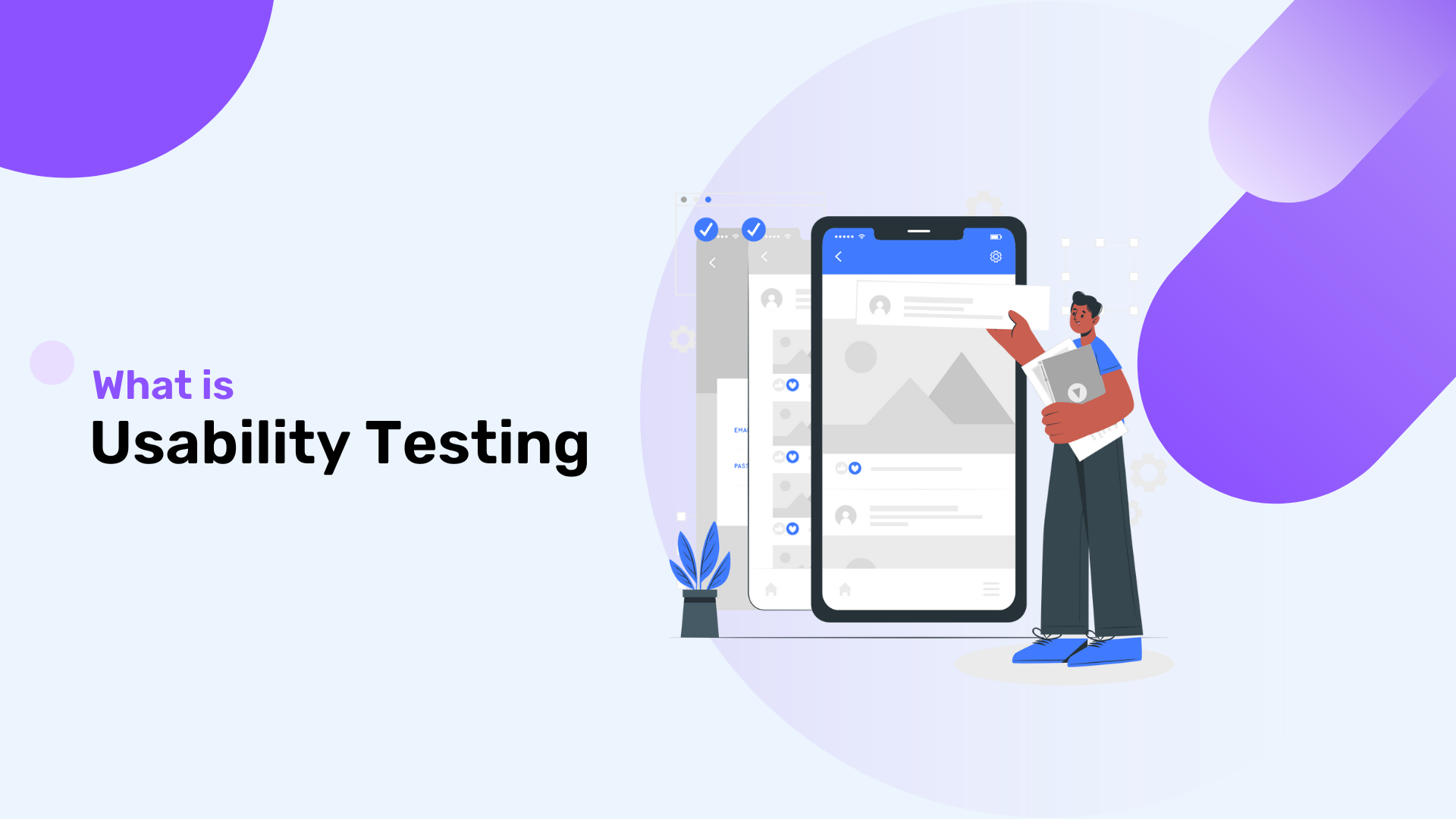Article content
Introduction
While designing an interface or a website, keeping your users at the center is important. Why? Because they are the ones who are going to use it. As a result, ensuring that your design is simple and easy is important. The design must help your user finish the task they want to. And this is where usability testing and usability step into the picture.
‘Usability testing’ and ‘usability’ are two concepts you often hear in the design or the UX world. Attached to this is the concept of usability design. Together, they ensure that your product is easy to use.
The question is: What do they each mean? What is their role, and why do they matter?
This blog will walk you through all you need to know about usability testing —
- What is usability?
- What does usability testing hint at?
- Purpose of usability testing and the need to measure it.
- How do you measure it and more?
What Is Usability?
To start with, let’s understand the usability definition.
Usability is the simplicity with which a user can complete tasks using your product. It includes the technical operation of a system and interface design. For the best customer experience (CX), designers check the usability across the development cycle.
It’s important to note the difference in usability vs. user experience. Usability is the ease of completing a task. In contrast, user experience refers to overall user satisfaction. In simple words, usability is a component of user experience.
Similarly, usability differs from accessibility. Accessibility is making the product equally accessible for everyone to use and enjoy. This is regardless of their abilities or the devices they use. Again, accessibility is a component of usability.
What Is Usability Testing?
Now that you are aware of usability meaning, how will you test it? How do you check if there is an issue in the user experience? Simple, via usability testing.
Usability testing is a technique for assessing the usability of a website or product. It helps UX researchers assess whether users can use their product quickly and intuitively. This is done by evaluating the usability with a sample set of its users or customers. Remember that this sample set is not just any group of people. Rather, it is a representative sample of the population.
Usability testing is often conducted at each step in the development process. Right from the initial release to the final product. But how do you perform a usability test?
During the study, a moderator gives participants a list of activities to perform. The rest of the team watches and takes notes. They carefully observe the following –
- Can the participant efficiently complete the task?
- Which part of the product makes the participant happy?
- Also, which part does the participant find difficult to use?
- Are they experiencing any confusion?
And so on. The team performs their research and assesses the findings. And then, they share them with the project manager.
What Is the Purpose of Usability Testing?
Even if you develop a conceptually wonderful product, it may still be ineffective. Ultimately annoying to use. To fix usability issues, usability instead depends on sound testing and research.
From this, the purpose of usability testing is clear. It entails –
- Discovering any issues in the user experience
- Deciding how to fix these usability issues
- Concluding if the product is usable
Why Should We Measure Usability?
When a product has good usability, customers complete their tasks efficiently. Ultimately, they will feel happy. This becomes crucial for product manufacturers to draw in customers. Better usability attracts customers. It also increases the likelihood that they’ll suggest the brand to others.
Website usability, in particular, is essential. When users find difficulty or misunderstanding, they might simply exit a website. Thus, it’s important to measure usability using a usability test to retain customers. It also facilitates the reduction of the bounce rate.
How Do You Measure Usability?
To measure usability, it’s important to see what you want to test, conduct user research, and more. Following is an overview of the usability testing process:
1. Choose What Do You Want to Test
Do you want to test the entire website or just the product page? Or do you want to check the usability of a specific interaction? Decide which particular part or feature of the product you want to test.
2. Choose Your Representative Sample
Who will you test the product on? Choose your representative sample after conducting user research. Why? Because user research helps define how your target audience looks, behaves, and prefers. And based on that, you will create a sample representative of your target audience.
3. Decide the Threshold
Be careful to establish precise standards for judging each task’s success. By deciding on success and failure levels, you may check if the user experience is simple.
Here, you can define the success or failure with the following usability metrics –
- Rate of Success – Number of participants able to complete the given task
- Duration – Time consumed to finish the task
- Rate of Error – What errors were made, how often, and how severe?
- User Satisfaction – What is your product’s level of user satisfaction?
- Ease of Performing – How efficiently can the users perform the task?
- Learnability – How quickly were the users able to understand basic navigation?
4. Outline a Plan
Your script should outline –
- Aim of the UX testing,
- Foundational information about products
- Questions for the customers, and more.
The moderator must follow the script to maintain neutrality, consistency, and objectivity.
5. Assign a Moderator and Shortlist Participants
A moderator has to stay neutral while conducting UX testing. Thus, choose a member who can do that, make participants comfortable, and guide them.
Also, select your participants from the sample to help you with the user experience. As mentioned, create a detailed user persona after user research and then choose.
6. Conduction
The next step is to conduct usability testing via user testing. During the process, follow the following guidelines –
- Ask participants to finish one task at a time.
- Do not help them if they are stuck. You want to see how long it takes them to complete it.
- Ask them to “think out loud” to understand what’s happening in their head.
- Ask post-task questions. Check what they found the easiest, most difficult, and somewhat challenging.
- See if they would recommend your product to some.
- Enquire if you can improve on something and more.
7. Analyze and Report
The final step is to analyze your finding, to make sense of it. In this step, focus on –
- Discovering patterns
- Sensitivity of issues
- Participant’s emotional response
Then, club everything together to develop a solution for user design. These are the recommendations for the design team. Create a report of the same and share it with them.
Usability Testing vs Heuristic Evaluation
The difference between usability testing and heuristic evaluation is of great importance. For starters, usability testing is performed by non-professional users. In contrast, heuristic evaluation is performed by experts with relevant skills.
Next, usability testing unfolds real problems. In contrast, heuristic evaluation tells you about potential or hidden problems. In the former, only a limited number of tasks are performed. Whereas in the latter, the experts follow predefined guidelines & checklists.
Usability testing improves functionality, while heuristic evaluation improves overall usability design and experience. Lastly, the latter is cost-effective and time-saving as compared to usability testing.
Methods of Usability Testing
Let’s now have a look at popular usability testing methods. The following are some of them –
1. Guerilla Testing
Also known as the Hallway testing method, it is one of the popular usability testing tools. You do the testing by setting up your research location where plenty of people walk by. It enables you to survey a group of individuals chosen at random about user experience. They are most likely to be unfamiliar with your service or website, such as bystanders.
2. Card Sorting
Write ideas (such as features) out on notecards. Then, ask participants to classify them into meaningful categories before assigning labels. It can help with organizing a website or mobile app. Also, it’s frequently utilized during the prototype or wireframing stages.
3. Remote Usability
As the name suggests, ‘remote’ indicates that the participant finishes a set of tasks at home. But the researcher may see the participant in a virtual environment if monitored. The participant may also record their session for a researcher to analyze later. That is if it is an unmonitored test.
4. Lab Usability
Lab Usability is conducted in a controlled setting where a moderator can watch the participant’s actions or inquire about them as they use a product. It requires a lot of control and organization. Also, it often has only a few participants. It is a usability testing tool suitable for in-depth, qualitative research.
5. Moderated Usability
This is a usability testing technique in which an industry expert moderates the usability test. The moderator works closely with the participant and assists them as they progress. Also, they respond to the participant’s queries if they encounter difficulties. Moderators often offer a more thorough analysis of the exam and its results.
Benefits of Usability Testing
The benefits of conducting usability testing are several and well-recognized. The following are some of them –
1. Saves Time & Effort
Conducting usability testing early during development helps with the early detection of issues. This saves time since the developers can quickly fix and build on the issues.
If done at a later stage when the product is completed, making changes may take longer. You may have to revise it more than expected to make it coherent.
2. Improves User Experience
Usability testing highlights the parts of your product that may not perform well. Also, it tells you what your target audience may find difficult to use. What are the challenges they will face? What tasks can be designed to complete efficiently? As a result, you can make the necessary changes. Thus, improving the user experience for the target audience.
3. Optimize Experience
A task they want to perform may be easy but take longer to complete. There is a scope for improvement here. With usability testing, you can find out the shortest possible way that’s easy. Thus optimizing user experience.
4. Unbiased Examination
The developing team puts a lot of hard work and time into creating a product. You may also get emotionally invested in the product or feel a sense of attachment to it. This may be a barrier when you want to objectively analyze a product.
Usability testing can help you objectively examine your product. Why? Because it is done by real users who are not emotionally vested in the product.
Tips to Improve Website Usability
Website usability can be improved in several ways with the help of usability principles. The following are some tips to improve it –
- Improve learnability by minimizing cognitive load during the decision process. Ensure the design is clear and simple so that users can easily find the options they are looking for. In short, declutter.
- Match the user’s expectations with your design. Make it familiar with what they are used to using yet distinct. Adopt a user-centric design for successful conversions.
- Make the processes simpler. Ensure your users do not have to put in a lot of effort. For instance, filling details in some or the other section of every checkout page.
- Use icons wherever possible and label them. They increase functionality and are easier to recall.
- Design alerts for possible errors. This will show the users where they went wrong, making it easier to fix. For instance, filling the date in the wrong format.
Conclusion
Usability testing is an important aspect of design and user experience. It can possibly make or break your product. Thus, choose the best usability testing method that suits your needs.
Furthermore, conduct it in the early stages. This is to avoid complex issues in the future and improve usability. Thus, offering your customers the best version of the products to simplify their life!


















